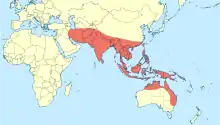| Pygmy wisp | |
|---|---|
 | |
| Male | |
 | |
| Female | |
| Scientific classification | |
| Domain: | Eukaryota |
| Kingdom: | Animalia |
| Phylum: | Arthropoda |
| Class: | Insecta |
| Order: | Odonata |
| Suborder: | Zygoptera |
| Family: | Coenagrionidae |
| Genus: | Agriocnemis |
| Species: | A. pygmaea |
| Binomial name | |
| Agriocnemis pygmaea | |
 | |
| Synonyms | |
| |
Agriocnemis pygmaea[3] (pygmy wisp)[4] is a species of damselfly in the family Coenagrionidae.[5] It is also known as wandering midget, pygmy dartlet or wandering wisp. It is well distributed across Asia and parts of Australia.[1][6]
Description and habitat
It is a small damselfly with black capped green eyes, black thorax with apple green stripes on lateral sides. Segments 1 to 7 of its abdomen is black on dorsum and pale green on ventral half. The remaining segments are orange-red. Very old males may get pruinosed on the dorsum of the head and the thorax with snowy white, making all the markings beneath being quite obscured. Female is more robust and exhibits several color morphs. The green color of the male is replaced by red in the females in the red forms. In androchrome forms, the female has same green colors as in the male.[7] Female colour variation is depended on ontogenic colour change associated with sexual development too.[8]
Etymology
The species name pygmaea is from the Greek word for pygmy. In 1842, Jules Pierre Rambur, writing in Latin, started his description of this damselfly: Minimum obscure viridi aenum - very small dark green copper.[2][13]
Gallery
 Female (androchrome)
Female (androchrome) Male
Male Female with water mites attached to her thorax
Female with water mites attached to her thorax.jpg.webp) Female wings
Female wings.jpg.webp) Male wings
Male wings Male, Thailand
Male, Thailand
See also
References
- 1 2 Subramanian, K.A. (2020). "Agriocnemis pygmaea". IUCN Red List of Threatened Species. 2020: e.T167280A83374189. doi:10.2305/IUCN.UK.2020-1.RLTS.T167280A83374189.en. Retrieved 20 November 2021.
- 1 2 Rambur, Jules (1842). Histoire naturelle des insectes. Névroptères (in French). Paris: Librairie Encyclopédique de Roret. pp. 534 [278] – via Gallica.
- ↑ Paulson, D.; Schorr, M.; Abbott, J.; Bota-Sierra, C.; Deliry, C.; Dijkstra, K.-D.; Lozano, F. (2023). "World Odonata List". OdonataCentral, University of Alabama. Retrieved 14 Mar 2023.
- ↑ Theischinger, Günther; Hawking, John (2006). The Complete Field Guide to Dragonflies of Australia. Collingwood, Victoria, Australia: CSIRO Publishing. p. 102. ISBN 978 0 64309 073 6.
- ↑ "Species Agriocnemis pygmaea (Rambur, 1842)". Australian Faunal Directory. Australian Biological Resources Study. 2012. Retrieved 6 April 2017.
- ↑ K.A., Subramanian; K.G., Emiliyamma; R., Babu; C., Radhakrishnan; S.S., Talmale (2018). Atlas of Odonata (Insecta) of the Western Ghats, India. Zoological Survey of India. pp. 142–143. ISBN 9788181714954.
- 1 2 C FC Lt. Fraser (1933). The Fauna of British India, including Ceylon and Burma, Odonata Vol. I. Red Lion Court, Fleet Street, London: Taylor and Francis. pp. 398-401.
- ↑ Joshi, Shantanu; Agashe, Deepa (2020). "Ontogenic colour change, survival, and mating in the damselfly Agriocnemis pygmaea Rambur (Insecta: Odonata)". Ecological Entomology. doi:10.1111/een.12879. Retrieved 1 May 2020.
- ↑ C FC Lt. Fraser (1924). A Survey of the Odonate (Dragonfly) Fauna of Western India and Descriptions of Thirty New Species (PDF). p. 490.
- ↑ Subramanian, K. A. (2005). Dragonflies and Damselflies of Peninsular India - A Field Guide.
- ↑ "Agriocnemis pygmaea Rambur, 1842". India Biodiversity Portal. Retrieved 2017-02-26.
- ↑ "Agriocnemis pygmaea Rambur, 1842". Odonata of India, v. 1.00. Indian Foundation for Butterflies. Retrieved 2017-02-26.
- ↑ Endersby, Ian; Fliedner, Heinrich (2015). The Naming of Australia's Dragonflies. Eltham, Victoria, Australia: Busybird Publishing. ISBN 9781925260625.
